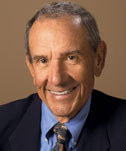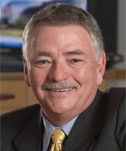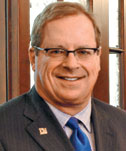2010 Report of Chancellor Mark A. Nordenberg: A Decade of Challenge, A Record of Impact and Distinction
This is the printed version of the report delivered by Chancellor Mark A. Nordenberg at the February 26, 2010, meeting of the University of Pittsburgh Board of Trustees.
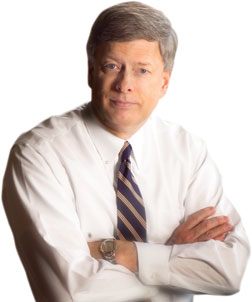 Chancellor Mark A. Nordenberg
Chancellor Mark A. NordenbergBidding Farewell to a Difficult Decade
Though some purists might argue that the first decade of the new century did not begin until January 1, 2001, and will not end until December 31, 2010, the great mass of humanity marked the end of that decade last December 31. Most observed its passing with relief.
The last 10 years have been called, without affection, the no-name decade, the lost decade, and the decade of zeros. Floyd Norris, writing in The New York Times, declared that the decade “richly earned the name ‘the zeros.’ For the entire developed world, that was just about the decade’s total return.” Time magazine pushed things even further, saying, “Goodbye (at Last) to the Decade from Hell” and calling the last 10 years “as awful as any peacetime decade in the nation’s entire history.” Paul Krugman, in his New York Times column, proposed that we “bid a not at all fond farewell to the Big Zero—the decade in which we achieved nothing and learned nothing.”
Particularly given such grim descriptions of the broader context, we can be proud of what was accomplished here during the last 10 years. Whatever happened elsewhere, the University of Pittsburgh built an accelerating record of high achievement and emerged as an even more productive center of learning. For us, this “lost decade” might more accurately be called a decade of impact and distinction.
Leading in Education
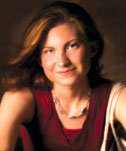 2010 Rhodes Scholar Eleanor Ott
2010 Rhodes Scholar Eleanor Ott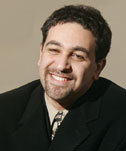 2007 Rhodes Scholar Daniel Armanios
2007 Rhodes Scholar Daniel Armanios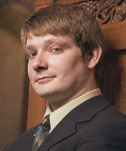 2006 Rhodes Scholar Justin Chalker
2006 Rhodes Scholar Justin ChalkerWhen our University was founded 223 years ago, its chartering legislation declared that “the education of youth ought to be a primary object with every government.” More than two centuries later, education—of both the young and the not so young—remains our most fundamental mission.
Our enrollment continues to grow and currently stands at about 35,500. In a typical year during the last decade, more than 33,500 students would have been enrolled in the undergraduate, graduate, and professional programs offered on Pitt’s five campuses. Those students are drawn from an increasingly talented and accomplished applicant pool.
In developing that talent, our educational programs have regularly produced students earning the very highest forms of national and international recognition. We saw one shining example this past fall, when we claimed our third Rhodes Scholar in the past five years. That level of sustained excellence more typically might be associated with an elite Ivy League institution than with a public university.
In Pitt’s community of high achievers, though, even our Rhodes Scholars do not stand alone. Instead, in the past decade, Pitt undergraduates also won, among other awards, a Gates Cambridge Scholarship, a Churchill Scholarship, three Udall Scholarships, five Marshall Scholarships, five Truman Scholarships, and 21 Goldwater Scholarships. These are among the most competitive honors awarded in American higher education.
The impact of our work as educators is seen not only in such notable forms of recognition but also is captured, day after day, by the tens of thousands of hardworking Pitt students who are crafting their own records of academic achievement while laying the foundation for lives of real meaning and impact. Many of them have expressed their gratitude for Pitt’s abundance of learning opportunities and for a University environment that fosters shared values and individual growth.
The student-sponsored I Love Pitt Day and designation of the student social and recreational center in the William Pitt Union as Nordy’s Place—which was less an individual tribute than it was a testament to our entire leadership team and especially to our student life professionals—are two relatively recent illustrations of student appreciation for Pitt’s nurturing community. This past year, to give one telling example of our successes in creating a culture built around the right values, we earned top recognition from a coalition of six national higher education organizations for our efforts to promote “a vibrant intellectual and social climate that deemphasizes the role of alcohol.” We also were recognized as one of the nation’s most veteran-friendly universities for our committed efforts to enhance the Pitt experiences of servicemen and servicewomen who are transitioning from the military to campus life.
We awarded nearly 76,000 University of Pittsburgh degrees during the past decade—degrees that represent the determined use of higher education to build the foundation for lives of impact, consistent with the “American dream.” And within the extended group of former Pitt students—also known as alumni—the past decade brought the very highest forms of recognition.
During the past decade, University of Pittsburgh graduates claimed, among many other honors, the Nobel Peace Prize, the Nobel Prize in Medicine, the National Medal of Science, the Pulitzer Prize for Fiction, the John Fritz Medal in engineering, the Shaw Prize and Albany Medical Center Prize in medicine, the Grainger Challenge Prize for Sustainability, and the Templeton Prize.
Pitt graduates also were elected to such prestigious organizations as the National Academy of Sciences, the Institute of Medicine, the National Academy of Engineering, and the American Academy of Arts and Sciences. And our alumni applied their special talents in such wide-ranging roles as chair of the National Science Board and music director of the New York Philharmonic.
Any institution of higher learning makes many of its most important contributions through the work of its graduates. And any university would be proud to claim Pitt’s list of high-achieving alumni.
Of course, we also are proud to claim the many tens of thousands of Pitt graduates whose careers may never carry them to these levels of national and international recognition but who lead productive lives and are contributing members of their home communities. In this regard, it is important to note that more than 80 percent of our undergraduates and more than 75 percent of our entire student body come from Pennsylvania and that 60 percent of our nearly 270,000 living alumni make their homes in the Commonwealth of Pennsylvania, a number that would be even higher if the state enjoyed more robust job growth.
Pioneering in Research
 London "Daily Mail" reporter Sam Fleming (right) with Pitt structural biology professor Joanne Yeh.
London "Daily Mail" reporter Sam Fleming (right) with Pitt structural biology professor Joanne Yeh.Pitt’s high-achieving faculty also have made the University an internationally respected center of pioneering research. At the close of the decade, we ranked fifth nationally in terms of the funds annually attracted by members of our faculty from the National Institutes of Health (NIH)—joining Harvard, Johns Hopkins, Penn, and the University of California at San Francisco (UCSF) in the NIH top five. We also rank in the top 10 nationally in total federal science and engineering research and development support. The other fine universities in that top 10 are Johns Hopkins, the University of Washington, Michigan, Penn, UCLA, Duke, Columbia, Stanford, and UCSF.
Pitt’s research expenditures during the past year totaled $654 million—and having claimed some $150 million in stimulus-supported grants, we expect to pass the $700 million mark in research expenditures this year. Over the course of the past decade, our research expenditures totaled an astounding $5.33 billion. Those largely imported, but locally spent, funds are an accepted sign of institutional stature, support research of impact, and have provided the fiscal foundation for tens of thousands of very good jobs right here in our home region.
During the past year, both before and after Pittsburgh’s G-20 Summit, this region attracted national and international attention for effecting an economic rebirth tied to university-based research. Over the course of the past decade, Pitt’s research prowess has been an essential factor in the launch of a wide range of technology-driven economic development initiatives. These include the Pittsburgh Life Sciences Greenhouse and The Technology Collaborative—as well as the Tech Collaborative’s predecessors, the Pittsburgh Digital Greenhouse and the Robotics Foundry.
Supporting such initiatives is a natural extension of the University’s own technology commercialization efforts, which still are of relatively recent vintage but have produced enviable results in recent years. During the past decade, our Office of Technology Management received 1,550 invention disclosures and filed 709 new U.S. patent applications. In addition, 303 new patents were issued, 443 license or option agreements were executed, and 59 start-up companies tied to Pitt technology were formed.
Of course, the University also has made significant contributions to the growth of the local economy through companies founded and led by its graduates. Consider two key examples drawn from biotechnology and information technology, both clusters of focus in regional economic growth.
• Jerry McGinnis, a young man from Illinois, came to Pitt to do graduate work in engineering, stayed in the region, and founded Respironics, which has become a major regional employer and a force in its area of specialty around the world.
• John Swanson, a young man from upstate New York, came to Pitt to do graduate work in engineering, stayed in the region, and founded ANSYS, Inc., which has become a major regional employer and a force in its area of specialty around the world.
More recently, Pitt graduates—who, like Swanson, also are Trustees—have played key roles in building further strength in the region’s growing energy sector.
Steve Tritch, as chair and CEO of Westinghouse Electric Company, played a key role in keeping that legendary Pittsburgh firm, with its rapidly growing nuclear power business, here in Western Pennsylvania despite determined efforts to lure the company to other parts of the country.
And Keith Schaefer, who had built the earlier stages of his distinguished career in California and reconnected with this region through his work with the Pitt Alumni Association, was named CEO of the Year by the Pittsburgh Technology Council for his outstanding efforts in leading BPL Global, Ltd., which is positioned to be one of this region’s great 21st-century commercial successes.
Supporting a World-Class Faculty
Of course, we would not be able to offer educational programs of distinction, engage in pioneering research, or drive regional economic development without an outstanding faculty. During the past decade, senior faculty colleagues were elected to membership in such prestigious groups as the National Academy of Sciences, Institute of Medicine, American Academy of Arts and Sciences, American Society for Clinical Investigation, American Association for the Advancement of Science, National Academy of Education, American Academy of Nursing, American Educational Research Association, and World Academy of Art and Science.
I did my best, as the decade unfolded, to underscore the many other exceptional honors regularly won by members of our faculty and cannot provide a complete retrospective now. However, as a reminder of the level and breadth of achievement that distinguishes our University, and with advance apologies to others whose honors might merit inclusion, let me provide a quick reminder of just a few examples. In the last 10 years, Pitt faculty members claimed, among many high honors:
• the National Medal of Science, this country’s highest scientific honor, and the Institute of Medicine’s Gustav O. Lienhard Award, given in recognition of outstanding achievements in improving health care services;
• the Charles S. Mott Prize, widely regarded as the highest honor in cancer research, and two American Cancer Society Research Professorships;
• the Andrew W. Mellon Foundation Distinguished Achievement Award for exemplary contributions to humanistic studies, one of the country’s largest and most prestigious awards of its type, and the Aquinas Medal of the American Catholic Philosophical Association;
• the MetLife Foundation Award for Medical Research in Alzheimer’s disease and the American Academy of Neurology’s Potamkin Prize, often labeled “the Nobel of neurology”;
• the Chauvenet Prize from the Mathematical Association of America and the David P. Robbins Prize from the American Mathematics Society, both awarded for pathbreaking success in solving the 400-year-old mathematical mystery known as the Kepler conjecture;
• the National Institutes of Health Director’s Pioneer Award, supporting novel investigator-initiated research even if it might carry a greater-than-usual risk of not succeeding;
• the American Medical Association Foundation’s Pride in the Profession Award for efforts to help poor, disabled, and disadvantaged patients and the Joy McCann Foundation Scholar award for extraordinary mentoring;
• a Guggenheim Fellowship, the Elizabeth Kray Award from Poets House, and the Barnes & Noble Writers for Writers Award for outstanding contributions to poetry;
• the Olin E. Teague Award and the Paul B. Magnuson Award, the highest honors of the U.S. Department of Veterans Affairs, for work with disabled veterans and for outstanding contributions to rehabilitation research, respectively;
• the Frederick Douglass Book Prize from the Gilder Lehrman Center for the Study of Slavery, Resistance, and Abolition at Yale University, the Merle Curti Award from the Organization of American Historians, the James A. Rawley Prize in Atlantic History from the American Historical Association, and the George Washington Book Prize (cosponsored by Washington College in Chestertown, Md., the Gilder Lehrman Institute of American History in New York City, and the Mount Vernon Ladies’ Association) for two exceptional volumes exploring the history and impact of slavery; and
• back-to-back presentations, an historic first, of the Mina P. Shaughnessy Prize, the highest honor presented by the Modern Language Association for outstanding work in the fields of language, culture, literacy, or literature with strong application to the teaching of English.
Based on the outstanding potential of their exceptional work, more junior faculty colleagues received such important forms of recognition and support as a Presidential Early Career Award for Scientists and Engineers, National Science Foundation Faculty Early Career Development Program awards, Howard Hughes Medical Institute Physician-Scientist Early Career Awards, National Institutes of Health Director’s New Innovator Awards, a Fulbright New Century Scholars Program award, Alfred P. Sloan Research Fellowships, a Pew Charitable Trusts Early Career Scholar award, and a Beckman Young Investigators Program award.
These, again, are examples from a much longer list of honors reflecting the past contributions, current strength, and growing potential of our faculty.
Fueling Job Growth and Adding to Community Vitality
Faculty teacher-scholars obviously make up one very important segment of the University’s 12,600-person employee base. Speaking more generally, the people of Pitt do the challenging work—in the many forms it takes—that is required to advance our important mission. And as our work has expanded over the course of the past decade, through both increased enrollment and a much larger portfolio of research, we have added more than 2,200 jobs. We also have remained committed to providing a supportive working environment for our faculty and staff. We were recognized by life scientists as one of the best places in academia to work in a survey conducted by The Scientist, and AARP named the University one of the best employers in the country for workers older than age 50.
A recent Newsweek cover story examined “the downside of downsizing” and boldly declared that “Layoffs Are Bad for Business.” That obviously is not always the case, but it is true for an institution whose basic business lines remain strong. And the demand for Pitt’s educational programs and research strengths is at an all-time high.
Maintaining a strong employment base at Pitt also is critical for our home region. Reflecting its continuing growth, the education and health services sector now is “the largest supersector in the local area, accounting for over one-fifth of Pittsburgh-area jobs,” according to the U.S. Department of Labor.
Looking at recent trends, the Bureau of Labor Statistics reported that, from March of 2008 to March of 2009, the Pittsburgh metropolitan area lost 7,400 manufacturing jobs; lost 5,300 leisure and hospitality jobs; lost 5,200 trade, transportation, and utilities jobs; lost 2,600 professional and business services jobs; lost 1,700 construction jobs; lost 1,100 information and 1,100 financial services jobs; and lost 1,000 government jobs.
In sharp contrast, the “only industry to gain at least 1,000 jobs in the local area was education and health services, which added 5,400 jobs” in that same period. It would be damaging to the region’s own best interests, then, to undermine job growth by creating an uncompetitive business climate for this important “supersector”—a concern triggered by the proposed city “tuition tax,” which was withdrawn, after a very public battle, just a few days before the end of the decade.
We obviously would prefer never to re-engage in that particular fight. However, if the clash produced any long-term benefits, one would have to be that we found ways to publicize and personalize the contributions made by our students. And, of course, the wide-ranging impacts of the University itself, as well as contributions made by individuals connected to the University, do play a major role in making our region what it is today.
Consider some of the big Pitt-related numbers—tied to impact just in Allegheny County, as opposed to the broader region—from the past decade:
• $48.7 billion earned by more than 70,000 Pitt graduates;
• $14.3 billion in direct and induced local spending by the University and its employees, students, and visitors;
• $11.7 billion in personal income generated by more than 34,000 Pitt-supported jobs; and
• $1.1 billion in local government revenues attributable to the presence of the University.
Of course, Pitt’s community contributions extend far beyond the numbers. The University is a dedicated institutional citizen, a commitment evidenced by the fact that Pitt was the country’s top-ranked public university in the 2009 edition of Saviors of Our Cities: A Survey of Best College and University Civic Partnerships. That assessment reflects our long-standing and determined efforts to strengthen the economy and enhance the overall quality of life in our home region.
Our strong athletic programs not only serve as a unifying force within the University but also provide a critical link to the broader community, and the past decade was an exciting period for Panther sports. Closing strong during the last year of the decade, Pitt was one of just four universities—along with Connecticut, Michigan State, and Oklahoma—that could claim a football team that participated in a bowl game, a men’s basketball team that made it to the NCAA Elite Eight, and a women’s basketball team that advanced to the NCAA Sweet 16.
Of course, success in competition is just one measure of a program’s worth. Our student-athletes also are a source of real pride because of the way that they represent our University, contribute to the broader community, and perform academically. During the last year of the past decade, 141 Pitt student-athletes earned grade point averages between 3.0 and 3.49; 93 earned GPAs between 3.5 and 3.99; and 12 student-athletes achieved perfect 4.0 grade point averages. Meagan Dooley, an outstanding member of our volleyball team, was named the Female Scholar-Athlete of the Year by the Big East Conference.
Success by our student-athletes—in competition, in the classroom, and in the community—does depend upon the guidance and support that they receive from their teacher-coaches. During the last year, head men’s basketball coach Jamie Dixon was named the 2009 Naismith Men’s College Basketball Coach of the Year. He then coached the U.S. under-19 team to its first gold medal since 1991 at the International Basketball Federation World Championships in New Zealand. For that success, he also was named the USA Basketball National Coach of the Year.
Our men’s and women’s basketball teams play their home games in the spectacular Petersen Events Center, considered by many to be the best place in the world to watch college basketball. “The Pete” is one of many key athletics construction projects completed in the last decade. Others include Heinz Field and the Duratz Athletic Complex in the UPMC Sports Performance Complex, facilities that our football team shares with the Pittsburgh Steelers. Major renovations to Fitzgerald Field House and Trees Hall and its pool were completed, and construction is well under way for our new Olympic sports complex, which also will be named after the extremely generous John and Gertrude Petersen.
Constructing a Better Community
Speaking more broadly, one characteristic of any vibrant region is physical growth. During the past decade, the University also made significant contributions to this key dimension of community progress. More specifically, the University completed 1,751 projects, involving construction expenditures of $1.142 billion and adding 2,191,739 square feet of space to University facilities.
The contention that nonprofit construction has been taking property off the City of Pittsburgh’s tax rolls is frequently asserted but seldom supported. An examination of key Pitt projects from the past decade suggests that this simply is not the case:
• The Petersen Events Center was constructed on the former site of Pitt Stadium, entirely within the footprint of the campus, and has been a source of increased amusement and parking tax revenues for the City;
• Pennsylvania Hall and Panther Hall, with a combined residence hall capacity of about 1,000 students, also were built on the former Pitt Stadium site and have helped to meet what had been identified by the City itself as its highest Pitt priority—building more on-campus undergraduate housing;
• The Sennott Square academic center was constructed within the accepted borders of our campus in Oakland on the most-blighted block of the Forbes Avenue business corridor. It includes both public parking and first-floor retail facilities that generate tax revenues on a site that had been tax exempt; and
• Our newest biomedical science tower was constructed on the least-attractive parcel of the Fifth Avenue business corridor, also within the accepted borders of the campus and also already tax exempt. It has become, as we intended, a magnet for the research dollars that now are so central to this region’s economy.
Key construction projects undertaken outside our traditional Oakland footprint most typically involved some form of partnering with the University of Pittsburgh Medical Center (UPMC), very often with UPMC taking the lead construction role. They include some of this era’s most stunning examples of community revitalization:
• UPMC built its Sports Performance Complex, part of which is occupied by Pitt, and Pitt constructed the headquarters building for the McGowan Institute for Regenerative Medicine, a joint venture of the University and UPMC, at the south end of the Hot Metal Bridge on the site of an abandoned steel mill. For many years, there had been nothing there. Those projects became early anchors for the entire SouthSide Works redevelopment, one of the city’s most celebrated successes;
• UPMC built the Hillman Cancer Center, one-half of which is occupied by University researchers, at the edge of its Shadyside campus. That development has advanced the city’s reputation as a center of world-class health care and research, generated new jobs, and created the potential for further growth in the Centre Avenue/Baum Boulevard corridor; and
• UPMC also reclaimed the campus of the former St. Francis Hospital, obviously already off the tax rolls, and constructed a magnificent new campus for Children’s Hospital of Pittsburgh of UPMC, including a pediatric research tower occupied by Pitt faculty members. That site otherwise would have been abandoned, and the Lawrenceville community would have suffered a devastating blow.
It is hard to imagine what today’s Pittsburgh region would be like without “eds and meds” developments of this type. It is even harder to imagine that anyone who has thought about the future of the region would not encourage such examples of growth.
In fact, the power of the “eds and meds” in driving economic development was underscored in three separate, but clearly related, news stories from this week [the week of February 21]. The first was the report that our Property and Facilities Committee had approved some $46 million in new capital projects spread across a number of campuses, but with the bulk of the work here in Oakland.
The second article, featured in the Pittsburgh Post-Gazette business section, was headlined, “No Vacancy: Office Space in Oakland Is Tighter than Ever.” That article reported a zero vacancy rate for Class A space in Oakland during the last quarter and quoted the president of a New York-based real estate holding company, who said, “In 20 years of doing commercial real estate, I don’t think I’ve seen a zero vacancy rate in a significant market comparable to Oakland.” That rate, the article went on to note, is even more unusual given what is happening in other markets as we move through the recession. As the article further points out, the key reason for the demand is clear: People want space near Oakland’s universities and medical institutions.
The third directly relevant news item was the report that Allegheny County is seeking a public-private partnership to develop a new mass transit system connecting downtown Pittsburgh and Oakland, the state’s second- and third-busiest commercial districts, and opening up new development possibilities for all of the flat land that lies between them. Creating such a link will not be easy. We already have lost out on one round of potential federal funding. However, making that mass transit connection would produce enormous benefits for the economies of this community and the Commonwealth.
Securing an Adequate Resource Base
Through much of the past decade, Pitt built great momentum as it moved into the modern era of private fundraising. We launched what was to have been a $500 million capital campaign, by far the largest in our history, in the fall of 2000. When we achieved that goal early, we doubled our goal to $1 billion, and when we achieved that milestone ahead of schedule, we doubled our goal again. Today, we stand near $1.5 billion as we move to what I believe will be this campaign’s final $2 billion goal.
The best fundraising year in our history was 2008, when we set multiple records—including those for campaign commitments made, gifts received, total number of donors, foundation support, and individual support. That year also was characterized by some very large, and well-targeted, contributions. Among those gifts of impact were the following:
• The Richard King Mellon Foundation, one of this University’s most generous supporters over the course of many years, made a $23 million gift to Pitt and Children’s Hospital of Pittsburgh of UPMC, enabling us to create the new Richard King Mellon Foundation Institute for Pediatric Research;
• The Bill & Melinda Gates Foundation, which had not provided major support to Pitt in the past, made two very large grants to our new Center for Vaccine Research: an $11.4 million grant to develop new strategies to control tuberculosis and a $10 million grant to support a vaccine modeling initiative;
• An anonymous donor made a $12 million bequest to create an endowment that will be a permanent source of scholarship support for commuter students at the University of Pittsburgh at Johnstown;
• And the high point of that record-setting year was the historic $41.3 million gift made by Trustee John Swanson to provide broad and flexible support to the school that now bears his name—the John A. Swanson School of Engineering.
When we launched what became our $2 billion campaign early in the last decade, I had said that our success would be measured less by the dollar total raised and more by what we did with that money. Over time, the critical difference that private support will make as we work to pursue our noble aspirations has become increasingly clear.
On the positive side, we see the impact of private giving in the more than 375 new endowed scholarship and fellowship funds that have been created during the past decade, a period during which our students and the families supporting them have felt increased financial pressure. We see it in the 70 new endowed chairs that have been created to support the work of leading members of our talented and committed faculty. And we see it in support for important programs of merit, ranging across the disciplines and throughout the institution.
Of course, the impact of private support also can be seen very visibly in essential physical improvements that would not be possible without such investments in Pitt. Three current projects provide telling examples of the critical difference that private support is making:
• Just last fall, we dedicated the new Mascaro Center for Sustainable Innovation, a model of cutting-edge green building design and construction processes, which sits at the heart of our sustainability initiatives and was made possible by the generosity and vision of two-time Pitt graduate Jack Mascaro;
• We are pressing forward with major renovations to Benedum Hall, in which the Swanson School of Engineering is principally housed. These upgrades to offices, classrooms, library, and laboratory facilities are one important part of what is being supported by Swanson’s historic gift;
• And, as earlier noted, the most recent gift from John and Gertrude Petersen has permitted us to move forward with the construction of what will be known as the Petersen Sports Complex, the future competition and training home for our baseball, softball, and soccer teams.
On a far less positive note, private support has become even more critical because state support for Pitt and for Pennsylvania’s other public research universities has been lagging. In fact, in terms of state funding, the past 10 years might fairly be labeled a “lost decade.” To provide some sense of longer-term patterns, trends from fiscal year (FY) 2001 through FY 2009 are revealing. During that period, the state’s general fund budget grew by nearly 40 percent; inflation increased by just more than 24 percent; support for community colleges rose by some 33 percent; support for the Pennsylvania State System of Higher Education increased by nearly 6 percent; and state support for Pitt increased by less than 0.3 percent. Also telling is the fact that actual commonwealth dollars invested in Pitt fell by more than 5 percent during that period, because some past state support was replaced by federal Medicaid matching funds.
The months of 2009, of course, presented their own special difficulties. By this time last year, we were well into the process of doing everything that was required to absorb two midyear appropriation cuts. That responsibility was shouldered without complaint, given the fact that we were moving through such economically challenging times. However, making the required adjustments—which included an institution-wide salary freeze—was not easy, either for the University or for its people.
If those midyear appropriation cuts were somewhat predictable once the recession had emerged, other major challenges from the past year were not. In midsummer, we faced the startling attempt to label the state-related universities as “nonpublic.” That designation would have resulted in tens of millions of dollars of additional losses, because all four institutions would have been denied federal stimulus funding and would have been deprived of certain state-funding protections built into federal law. Fortunately, not only for the involved institutions but for the cause of public higher education, that position was not accepted by the U.S. Department of Education.
However, that was not the end of our special challenges. Because of ongoing disputes over gaming legislation, we were nearly halfway through the current fiscal year, into the second half of December, before our appropriation finally was approved, and our first appropriation payment was not received until early February. Particularly because we had acted, in good faith, to hold tuition increases to very low levels, this delay created a high level of anxiety among our students and their families. It also resulted in financial strains and an inability to plan effectively within the institution.
In the budget that has been proposed for the next fiscal year, funding for the Department of Education would increase by just more than 4 percent, with state support for basic education increasing by nearly 5 percent. In contrast, funding for the University of Pittsburgh and the other state-related universities would stay at the same level as the current fiscal year. This is the continuation of a clear and extended pattern. Compared to FY 2003, for example, state support for basic education will have increased by 43 percent, while actual state dollars allocated to the University of Pittsburgh will have remained the same.
Obviously, flat funding is better than the cuts that were endured last year and in other recent years. However, flat funding will not provide any support for the cost increases that are a virtual certainty. Even more troubling is the fact that federal stimulus funding, upon which two successive state budgets will have been built, is scheduled to disappear in FY 2012. This “funding cliff” threatens to produce larger state budget deficits and likely will result in even greater pressures on funding for public higher education. Some protections have been built into basic education funding lines, and consideration should be given to similarly responsible planning for higher education.
Building Our Future Together
Though we might wish it were not so, in today’s world, little that is worthwhile seems to be easy. But difficulties also can be overstated. Returning for a moment to Time magazine’s cover story on the past decade, this is a part of what was written to support its deliberately provocative “Decade from Hell” characterization:
“At exactly two minutes after midnight on Jan. 1, 2000, an alarm sounded at a nuclear power plant in Onagawa, Japan. Government officials and computer scientists around the globe held their breath. Was this the beginning of a massive Y2K computer meltdown? Actually, no. It was an isolated event, one of a handful of glitches to occur (including the failure of 500 slot machines at two racetracks in Delaware) as the sun rose on a new decade. The dreaded millennial meltdown never happened.
“Instead, it was the American Dream that was about to dim. Bookended by 9/11 at the start and a financial wipeout at the end, the first 10 years of this century will very likely go down as the most dispiriting and disillusioning decade Americans have lived through in the post-World War II era. We’re still weeks away from the end of ’09, but it’s not too late to pass judgment. Call it the Decade from Hell, or the Reckoning, or the Decade of Broken Dreams, or the Lost Decade. Call it whatever you want—just give thanks that it is nearly over.”
Without question, the last 10 years were a time of great challenge. From terrorist attacks at home to wars abroad, from the Asian tsunami to Hurricane Katrina, from the collapse of the economy to record-setting Ponzi schemes—you might say that we saw it all. Even in our little corner of the world and on a smaller scale, we saw things that many of us never thought would come our way; recent attempts to label us nonpublic and to assess the tuition tax are two end-of-decade examples that quickly come to mind.
But what we also saw here at Pitt was the brightening light, not a dimming, of the American Dream. In fact, we saw the significant advancement of that dream—in the face of real tests and on many fronts—in the inspiring development of our students, in the exciting expansion of human knowledge, and in the committed advancement of the public good.
We know that more obstacles await us, but we also know, from 223 years of proud Pitt history and from our own more recent experiences, that the people of this University always have found ways to meet whatever challenges confronted them and have pushed forward effectively with the University’s important work. That is a record of progress that none of us would like to break.
And so, in the weeks and months and years ahead, we will keep pushing forward—not only dealing with problems but also seizing opportunities, building momentum, enhancing our quality, extending our impact, and enjoying the fact that we are doing it together. As Franklin Delano Roosevelt wrote to Winston Churchill—and just think about what they went through together—“It is fun to be in the same decade with you.”
We almost certainly are heading down what will continue to be a rough road. However, no one knows more about dealing with potholes than people from Pittsburgh. And if we remember our proud history, remain committed to our noble mission, and continue to support each other, we should be able to make it a deeply satisfying, even if not entirely smooth, ride.
Other Stories From This Issue
On the Freedom Road

Follow a group of Pitt students on the Returning to the Roots of Civil Rights bus tour, a nine-day, 2,300-mile journey crisscrossing five states.
Day 1: The Awakening
Day 2: Deep Impressions
Day 3: Music, Montgomery, and More
Day 4: Looking Back, Looking Forward
Day 5: Learning to Remember
Day 6: The Mountaintop
Day 7: Slavery and Beyond
Day 8: Lessons to Bring Home
Day 9: Final Lessons

